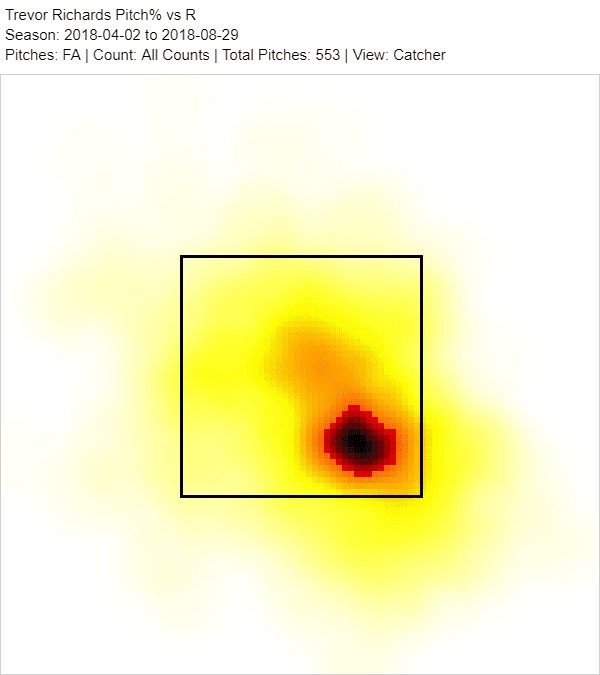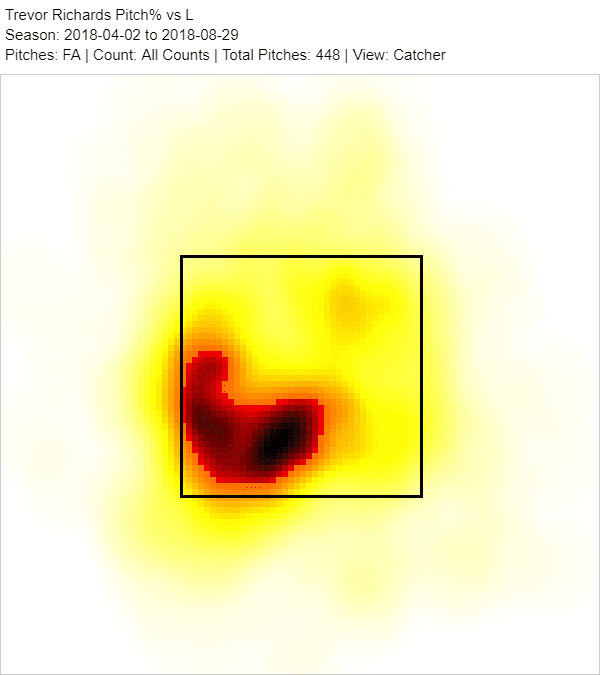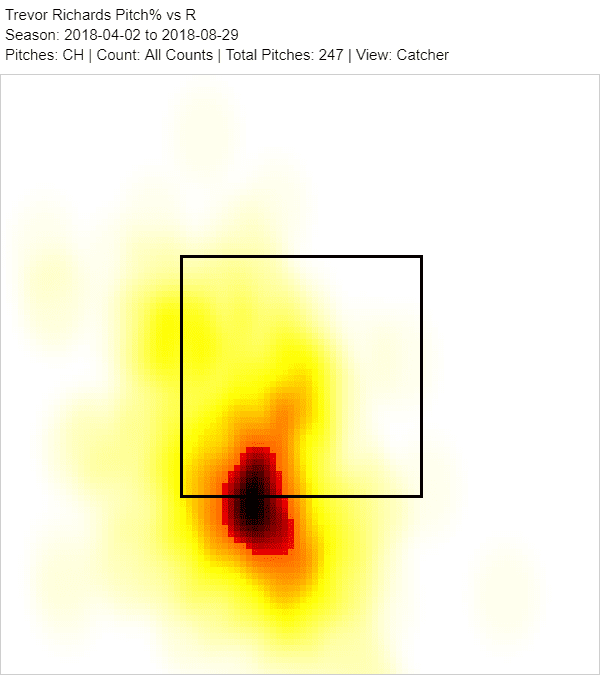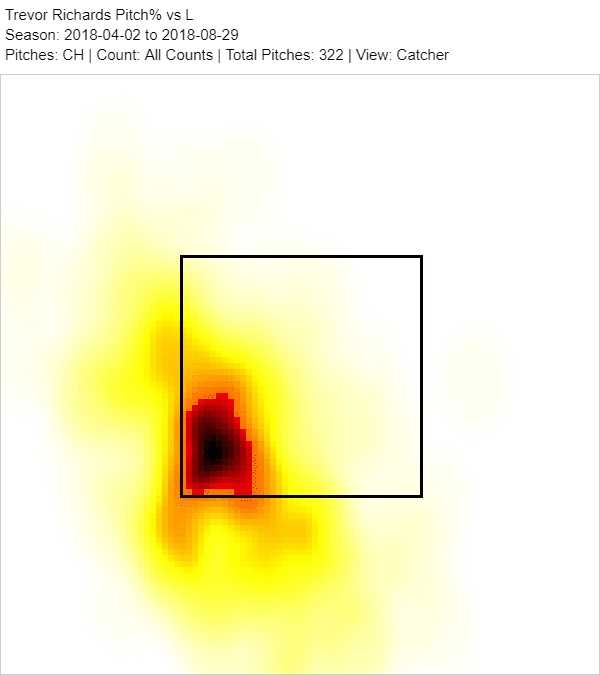
It’s the home stretch, with many owners more aggressive on the wire than ever as the season winds down. With September upon us, the schedule and a player’s recent performance are more meaningful than at any other point of the season. With that in mind, today I’ll look at Trevor Richards and Michael Conforto, two players who stand to benefit from their upcoming opponents and are showing some under-the-radar promise as the season winds to a close.
Michael Conforto
Michael Conforto’s had a down year, slashing .232/.346/.404 after a breakout 2017 season in which he hit .279 with 27 home runs in less than a full season’s worth of playing time. His Statcast batted ball data explains the decline. His average exit velocity on balls hit in the air is down two miles per hour from last season and his average fly ball shorter by five feet.
 These differences may seem subtle, but they’re not. Consider that Dr. Alan Nathan found that an additional five feet on fly balls increased home-run output by 15 percent in 2017. While Dr. Nathan’s study was examining the effects of the baseball on the entire league, the point applies to Conforto specifically- lose even a few feet on your fly balls, you lose some home runs. Statcast agrees, estimating that Conforto’s batted balls last season “should have” resulted in a .521 slugging percentage; this season, his expected slugging is a mere .418.
These differences may seem subtle, but they’re not. Consider that Dr. Alan Nathan found that an additional five feet on fly balls increased home-run output by 15 percent in 2017. While Dr. Nathan’s study was examining the effects of the baseball on the entire league, the point applies to Conforto specifically- lose even a few feet on your fly balls, you lose some home runs. Statcast agrees, estimating that Conforto’s batted balls last season “should have” resulted in a .521 slugging percentage; this season, his expected slugging is a mere .418.
While we can’t know for sure, it is easy to trace Conforto’s power outage to the gruesome shoulder injury that ended his 2017 season. Conforto was playing again by April, but it’s easy to see how shoulder weakness could’ve been affecting his bat speed throughout this season. As he gets further removed from the injury, we would expect him to get stronger. Conforto’s progress this season hasn’t been linear, but August was encouraging. His average exit velocity for the month ranked tenth in baseball (minimum 25 plate appearances), and his 46.4% hard contact rate was his best of the season.
Additionally, Conforto’s got a decent slate for September. He’ll head to Fenway and to Citizens Bank Park for a week in the middle of the month, and seven of the Mets’ final 27 games of the year are against the worst run-prevention pitching staff in baseball (Miami). He’ll face some talented pitchers outside of Miami (and one in Miami- more on that in a minute), but he’ll have some favorable hitting environments in which to work.
It’s not all rosy with Conforto. In addition to being his highest power month, August was his most strikeout-prone one. Maybe you’d have liked his injury recovery to be a little more linear to be fully convinced that he’s healthy. He’s not a surefire star.
But exit velocity can serve as a useful proxy for health, and Conforto’s exit velocity being up five miles per hour last month seems to be an indicator that he’s feeling better than he was early on. He’s pulling the ball more, too, and he hit fastballs harder in August than in any month this season. It looks like the bat speed is coming back, like he’s starting to regain some of his explosiveness. If the bat-to-ball skills follow in September, owners could ride the wave for the rest of the year.
Trevor Richards
As mentioned, Miami’s pitching staff is terrible. On the surface, it looks as though Trevor Richards would be part of the problem, not the solution. With a mediocre 4.26 ERA and a 91.5 MPH fastball, he’s not a guy many owners are dying to own. Yet despite the modest arm speed, Richards gets pretty good results.
His strikeout rate is above-average, and over the past month, he’s been a top-20 starting pitcher by swinging strike rate. Recently, he’s really leaned on a wipeout changeup which has been one of the league’s best all year. What’s more, Richards seems to have an advanced ability to locate, a must for a pitcher with below-average velocity. Consider where Richards has spotted his fastballs.
First, to right-handed hitters:
And against lefties:
The plan becomes even more apparent when looking at Richards’ changeups.
Against right-handers:
And left-handers:
Richards stays down and away, keeping his home run rate down by never giving in. It’s not an eye-popping profile, but it’s an effective one.
Like Conforto, Richards’ schedule lines up nicely. He’ll next take the ball this Tuesday against Philadelphia at home, and, if Miami adheres to a standard five-man rotation, should get a road start against the Mets, a start in Philadelphia, one at home against Cincinnati before finishing his season in Washington. None of those four teams have above-average lineups, and his two starts at home and trip to Citi Field have the benefit of coming in pitcher-friendly home parks. Counting on the Marlins for wins isn’t advisable, but Richards seems to be in a position to pick up a few more strikeouts with decent ratios the rest of the way.
 Keep up with all the latest Fantasy Baseball news with Van Lee, Jeff Zimmerman and Rob Silver on the Launch Angle Podcast.
Keep up with all the latest Fantasy Baseball news with Van Lee, Jeff Zimmerman and Rob Silver on the Launch Angle Podcast.





